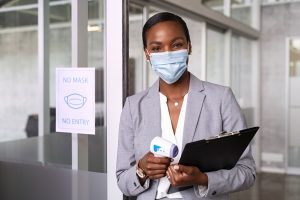The EEOC has updated its COVID-19 Guidance to follow the updated June guidance from the CDC. As of July 12, 2022, the following are some of the revisions in effect:
- Medical Documentation Clearing an Employee to Work
Under the updated guidance, an employer may require confirmation from a qualified medical professional stating that an employee who has had COVID-19 is safe to return to work and can perform their job duties. However, the guidance continues to say that employers should consider other options, such as following the most up-to-date CDC guidance to determine the safety of returning an employee to the workplace without such medical confirmation.
- Testing required by Employers

An employer can still require an employee to have a COVID test but only if it is “job-related and consistent with business necessity.” This recognizes that while this standard was always met early on in the pandemic, it now requires an assessment of whether the specific circumstances of the pandemic generally and the individual workplace justify the testing. According to the updated guidance, possible considerations in making the “business necessity” assessment may include:
the level of community transmission; the vaccination status of employees; the accuracy and speed of processing for different types of COVID-19 viral tests; the degree to which breakthrough infections are possible for employees who are “up to date” on vaccinations; the ease of transmissibility of the current variant(s); the possible severity of illness from the current variant; what types of contacts employees may have with others in the workplace or elsewhere that they are required to work (e.g., working with medically vulnerable individuals); and the potential impact on operations if an employee enters the workplace with COVID-19.
- Applicability to Applicants
An employer can still screen applicants for COVID-19 after making a conditional job offer, as long as it does so for all entering employees in the same type of job. This rule applies whether or not the applicant has a disability. Also, if the employer screens everyone entering a worksite (employees, applicants, contractors, visitors, etc.) for symptoms of COVID-19, then an applicant in the pre-offer stage who needs to be in the workplace as part of the application process (i.e., for a job interview) may likewise be screened for COVID-19. This is important because under the ADA, disability-related inquiries and medical examinations are generally prohibited before an employer makes a conditional job offer to an applicant. To that end, the screening is limited to the same screening that everyone else undergoes; an employer that goes beyond that screening will have engaged in an illegal pre-offer disability-related inquiry and/or medical examination.
- Withdrawal of Job Offer
There are some changes to this process. Under the prior guidance, the EEOC allowed an employer to withdraw a job offer to an applicant with COVID-19 when that applicant was needed on site immediately. Now, the guidance says an employer should follow current CDC guidance that explains when and how it would be safe for an individual who has COVID, symptoms of COVID or recently been exposed to someone with COVID to end isolation or quarantine. An employer who follows current CDC guidance can withdraw a job offer when: (1) the job requires an immediate start date, (2) CDC guidance recommends the person not be in proximity to others, and (3) the job requires such proximity to others, whether at the workplace or elsewhere. An employer may still not postpone the start date or withdraw a job offer because of the employer’s concern that the individual is older, pregnant, or has an underlying medical condition that puts the individual at increased risk from COVID-19.
- Requesting reasonable accommodation due to high risk medical condition
The guidance clarifies that in this situation the employee (or someone on his/her behalf such as a doctor) must let the employer know that the employee needs a reasonable accommodation for a reason related to a medical condition. The request can be made orally or in writing and does not have to contain the specific language of a “reasonable accommodation” or reference the ADA.
As with other requests based on a potential disability, the employee or the employee’s representative should communicate that the employee has a medical condition necessitating a change to meet a medical need. After receiving a request, the employer may ask questions or seek medical documentation to help decide if the individual has a disability and if there is a reasonable accommodation, absent undue hardship, that can be provided.
- Sharing Employee Vaccination Information

The updated guidance confirms that the ADA requires an employer to maintain the confidentiality of employee medical information. Although these laws do not prevent employers from requiring its employees to provide documentation or other confirmation of vaccination, this information, like all medical information, must be kept confidential and stored separately from the employee’s personnel files under the ADA.
An employer may share confidential medical information, such as confirmation of employee vaccinations (or COVID-19 test results), with employees who need it to perform their job duties. However, such employees also must keep the information confidential. Some possible scenarios include:
- An administrative employee assigned to perform recordkeeping of employees’ documentation of vaccination may receive needed access to the information for this purpose but must keep this information confidential.
- An employee assigned to permit building entry only by employees who are in compliance with a work restriction, such as COVID-19 vaccinations, testing, and/or masking, should only receive a list of the individuals who may (or may not) enter, but not any confidential medical information about why they are on (or not on) the list.
- An employee tasked to ensure compliance with a testing requirement for employees would need to review testing documentation submitted by those employees but must keep that testing information confidential.
We will continue to keep you updated as to any further relevant revisions but encourage everyone to remain vigilant in checking for updates from the CDC and/or EEOC.

